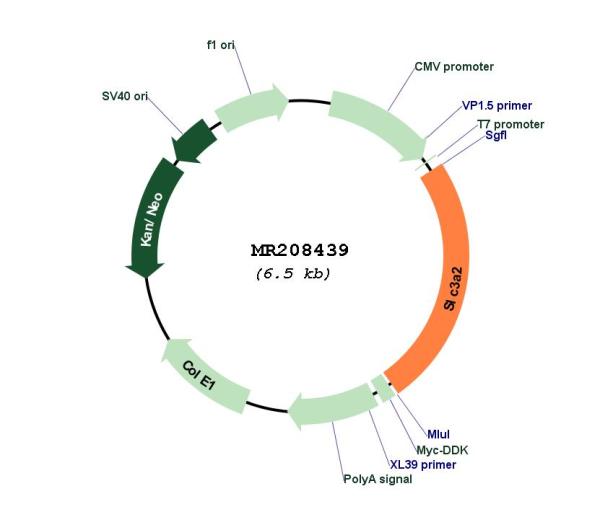Slc3a2 (NM_008577) Mouse Tagged ORF Clone
CAT#: MR208439
- TrueORF®
Slc3a2 (Myc-DDK-tagged) - Mouse solute carrier family 3 (activators of dibasic and neutral amino acid transport), member 2 (Slc3a2), transcript variant 2
ORF Plasmid: tGFP
Lentiviral Particles: DDK w/ Puro mGFP w/ Puro
AAV Particle: DDK
"NM_008577" in other vectors (4)
Interest in protein/lysate? Submit request here!
USD 198.00
Specifications
| Product Data | |
| Type | Mouse Tagged ORF Clone |
| Tag | Myc-DDK |
| Symbol | Slc3a2 |
| Synonyms | 4F2; 4F2HC; AI314110; Cd98; Ly-10; Ly-m10; Ly10; Mdu1; Mgp-2hc; NACAE |
| Vector | pCMV6-Entry |
| E. coli Selection | Kanamycin (25 ug/mL) |
| Mammalian Cell Selection | Neomycin |
| Sequence Data |
>MR208439 ORF sequence
Red=Cloning site Blue=ORF Green=Tags(s) TTTTGTAATACGACTCACTATAGGGCGGCCGGGAATTCGTCGACTGGATCCGGTACCGAGGAGATCTGCC GCCGCGATCGCC ATGAGCCAGGACACCGAAGTGGACATGAAAGATGTGGAGCTGAACGAGCTAGAACCGGAGAAGCAGCCCA TGAATGCAGCGGACGGGGCGGCGGCCGGGGAGAAGAACGGTCTGGTGAAGATCAAGGTGGCGGAGGACGA GACGGAGGCCGGGGTCAAGTTCACCGGCTTATCCAAGGAGGAGCTACTGAAGGTAGCGGGCAGCCCTGGC TGGGTGCGCACCCGCTGGGCGCTGCTGCTGCTCTTCTGGCTCGGTTGGCTGGGCATGCTGGCGGGCGCCG TGGTTATCATCGTTCGGGCGCCGCGCTGCCGTGAGCTGCCTGTACAGAGGTGGTGGCACAAGGGCGCCCT CTACCGCATCGGCGACCTTCAGGCCTTTGTAGGCCGGGATGCGGGAGGCATAGCTGGTCTGAAGAGCCAT CTGGAGTACTTGAGCACCCTGAAGGTGAAGGGCCTGGTGTTAGGCCCAATTCACAAGAACCAGAAGGATG AAATCAATGAAACCGACCTGAAACAGATTAATCCCACTTTGGGCTCCCAGGAAGATTTTAAAGACCTTCT ACAAAGTGCCAAGAAAAAGAGCATTCACATCATTTTGGACCTCACTCCCAACTACCAGGGCCAGAATGCG TGGTTCCTCCCTGCTCAGGCTGACATTGTAGCCACCAAAATGAAGGAAGCTCTGAGTTCTTGGTTGCAGG ACGGTGTGGATGGTTTCCAATTCCGGGATGTGGGAAAGCTGATGAATGCACCCTTGTACTTGGCTGAGTG GCAGAATATCACCAAGAACTTAAGTGAGGACAGGCTTTTGATTGCAGGGACTGAGTCCTCTGACCTGCAG CAAATTGTCAACATACTTGAATCCACCAGCGACCTGCTGTTGACCAGCTCCTACCTGTCAAATTCCACTT TCACTGGGGAGCGTACTGAATCCCTAGTCACTAGGTTTTTGAATGCCACTGGCAGCCAATGGTGCAGCTG GAGTGTGTCGCAAGCAGGACTCCTCGCAGACTTTATACCGGACCATCTTCTCCGACTCTACCAGCTGCTG CTCTTCACTCTGCCAGGGACTCCTGTTTTTAGCTACGGGGATGAGCTTGGCCTTCAGGGTGCCCTTCCTG GACAGCCTGCGAAGGCCCCACTCATGCCGTGGAATGAGTCCAGCATCTTTCACATCCCAAGACCTGTAAG CCTCAACATGACAGTGAAGGGCCAGAATGAAGACCCTGGCTCCCTCCTTACCCAGTTCCGGCGGCTGAGT GACCTTCGGGGTAAGGAGCGCTCTCTGTTGCACGGTGACTTCCATGCACTGTCTTCCTCACCTGACCTCT TCTCCTACATACGACACTGGGACCAGAATGAGCGTTACCTGGTGGTGCTCAACTTCCGAGATTCGGGCCG GTCAGCCAGGCTAGGGGCCTCCAACCTCCCTGCTGGCATAAGCCTGCCAGCCAGCGCTAAACTTTTGCTT AGTACCGACAGTGCCCGGCAAAGCCGTGAGGAGGACACCTCCCTGAAGCTGGAAAACCTGAGCCTGAATC CTTATGAGGGCTTGCTGTTACAGTTCCCCTTTGTGGCC ACGCGTACGCGGCCGCTCGAGCAGAAACTCATCTCAGAAGAGGATCTGGCAGCAAATGATATCCTGGATT ACAAGGATGACGACGATAAGGTTTAA >MR208439 protein sequence
Red=Cloning site Green=Tags(s) MSQDTEVDMKDVELNELEPEKQPMNAADGAAAGEKNGLVKIKVAEDETEAGVKFTGLSKEELLKVAGSPG WVRTRWALLLLFWLGWLGMLAGAVVIIVRAPRCRELPVQRWWHKGALYRIGDLQAFVGRDAGGIAGLKSH LEYLSTLKVKGLVLGPIHKNQKDEINETDLKQINPTLGSQEDFKDLLQSAKKKSIHIILDLTPNYQGQNA WFLPAQADIVATKMKEALSSWLQDGVDGFQFRDVGKLMNAPLYLAEWQNITKNLSEDRLLIAGTESSDLQ QIVNILESTSDLLLTSSYLSNSTFTGERTESLVTRFLNATGSQWCSWSVSQAGLLADFIPDHLLRLYQLL LFTLPGTPVFSYGDELGLQGALPGQPAKAPLMPWNESSIFHIPRPVSLNMTVKGQNEDPGSLLTQFRRLS DLRGKERSLLHGDFHALSSSPDLFSYIRHWDQNERYLVVLNFRDSGRSARLGASNLPAGISLPASAKLLL STDSARQSREEDTSLKLENLSLNPYEGLLLQFPFVA TRTRPLEQKLISEEDLAANDILDYKDDDDKV |
| Restriction Sites |
SgfI-MluI
Cloning Scheme for this gene
Plasmid Map

|
| ACCN | NM_008577 |
| ORF Size | 1581 bp |
| OTI Disclaimer | The molecular sequence of this clone aligns with the gene accession number as a point of reference only. However, individual transcript sequences of the same gene can differ through naturally occurring variations (e.g. polymorphisms), each with its own valid existence. This clone is substantially in agreement with the reference, but a complete review of all prevailing variants is recommended prior to use. More info |
| OTI Annotation | This clone was engineered to express the complete ORF with an expression tag. Expression varies depending on the nature of the gene. |
| Product Components | The ORF clone is ion-exchange column purified and shipped in a 2D barcoded Matrix tube containing 10ug of transfection-ready, dried plasmid DNA (reconstitute with 100 ul of water). |
| Reconstitution | 1. Centrifuge at 5,000xg for 5min. 2. Carefully open the tube and add 100ul of sterile water to dissolve the DNA. 3. Close the tube and incubate for 10 minutes at room temperature. 4. Briefly vortex the tube and then do a quick spin (less than 5000xg) to concentrate the liquid at the bottom. 5. Store the suspended plasmid at -20°C. The DNA is stable for at least one year from date of shipping when stored at -20°C. |
| Reference Data | |
| RefSeq | NM_008577.4 |
| RefSeq Size | 2572 bp |
| RefSeq ORF | 1581 bp |
| Locus ID | 17254 |
| UniProt ID | P10852 |
| Cytogenetics | 19 5.44 cM |
| MW | 58.3 kDa |
| Gene Summary | Component of several heterodimeric amino acid transporter complexes. The precise substrate specificity depends on the other subunit in the heterodimer (PubMed:9915839). The heterodimer with SLC3A2 functions as sodium-independent, high-affinity transporter that mediates uptake of large neutral amino acids such as phenylalanine, tyrosine, L-DOPA, leucine, histidine, methionine and tryptophan (PubMed:9915839). The complexes with SLC7A6 and SLC7A7 mediate uptake of dibasic amino acids. The complexes function as amino acid exchangers (By similarity). Required for targeting of SLC7A5 and SLC7A8 to the plasma membrane and for channel activity (PubMed:9915839). Plays a role in nitric oxide synthesis in human umbilical vein endothelial cells (HUVECs) via transport of L-arginine (By similarity). The heterodimer with SLC7A5/LAT1 may play a role in the transport of L-DOPA across the blood-brain barrier (Probable). May mediate blood-to-retina L-leucine transport across the inner blood-retinal barrier (By similarity). The heterodimer with SLC7A5/LAT1 can mediate the transport of thyroid hormones triiodothyronine (T3) and thyroxine (T4) across the cell membrane. When associated with SLC7A5 or SLC7A8, involved in the cellular activity of small molecular weight nitrosothiols, via the stereoselective transport of L-nitrosocysteine (L-CNSO) across the transmembrane. The heterodimer with SLC7A5 is involved in the uptake of toxic methylmercury (MeHg) when administered as the L-cysteine or D,L-homocysteine complexes. Together with ICAM1, regulates the transport activity SLC7A8 in polarized intestinal cells, by generating and delivering intracellular signals. When associated with LAPTM4B, the heterodimer formed by SLC3A2 and SLC7A5 is recruited to lysosomes to promote leucine uptake into these organelles, and thereby mediates mTORC1 activation (By similarity).[UniProtKB/Swiss-Prot Function] |
Documents
| Product Manuals |
| FAQs |
| SDS |
Resources
Other Versions
| SKU | Description | Size | Price |
|---|---|---|---|
| MC202720 | Slc3a2 (untagged) - Mouse solute carrier family 3 (activators of dibasic and neutral amino acid transport), member 2 (Slc3a2), transcript variant 2, (10ug) |
USD 491.00 |
|
| MG208439 | Slc3a2 (tGFP-tagged) - Mouse solute carrier family 3 (activators of dibasic and neutral amino acid transport), member 2 (Slc3a2) |
USD 691.00 |
|
| MR208439L3 | Lenti ORF clone of Slc3a2 (Myc-DDK-tagged) - Mouse solute carrier family 3 (activators of dibasic and neutral amino acid transport), member 2 (Slc3a2), transcript variant 2 |
USD 791.00 |
|
| MR208439L4 | Lenti ORF clone of Slc3a2 (mGFP-tagged) - Mouse solute carrier family 3 (activators of dibasic and neutral amino acid transport), member 2 (Slc3a2), transcript variant 2 |
USD 791.00 |
{0} Product Review(s)
Be the first one to submit a review






























































































































































































































































 Germany
Germany
 Japan
Japan
 United Kingdom
United Kingdom
 China
China


